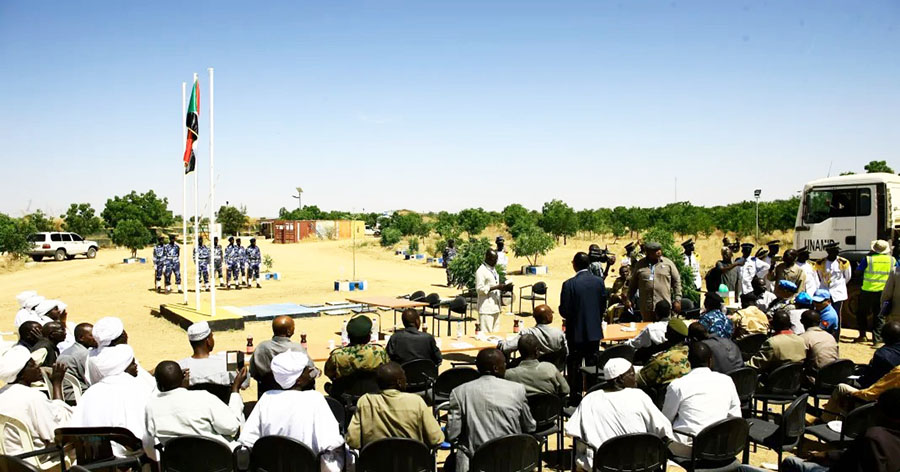
Why Is It So Hard for Peace Operations to Exit Well? Lessons from UNAMID in Sudan
By: Silvia Danielak*
Source: peacenews.com
Between 2019 and 2021, peacekeepers in Darfur, Sudan closed most of their mission’s camps, handing over the sites and infrastructure built on them to local governments and partners. It was not to last. Within days of the handover ceremonies, looters ransacked most of the camps, stripping them of furniture and equipment, and torching what remained. Little was left of the compounds that could have benefited the local government and the population of Darfur. How could, despite years of planning, the well-intended handover go so wrong?
After the fourth anniversary of the completed withdrawal of mission staff from United Nations–African Union Hybrid Operation in Darfur (UNAMID) on June 30, and as more peacekeeping missions are likely close in the near future, it is timely to delve into the infrastructural, material dimension of peace operations’ transition and examine the efforts preceding the handing over of infrastructure to local communities.
For those following current events in Sudan, the situation presents itself as a déjà vu. Since 2023, Sudan has been swept into a fierce civil war and a sprawling humanitarian crisis, following a series of coups that have shaken the nation post-UNAMID. Looking back, the mission’s bungled transition seems to have added to instability rather than peace. But let’s take it one step at a time.
Three insights from reviewing the planning for the closure of the African Union-United Nations Hybrid Operation in Darfur (UNAMID, 2007-2020) highlight both the ambitions and failures inherent in such endeavors.
An Ambitious Mission with a Large Footprint
Back in 2007, UNAMID was established in response to the dire humanitarian crisis in Sudan, marked by violent conflict and mass displacement. UNAMID’s mission was ambitious, aiming to protect civilians, facilitate humanitarian aid, and support peacebuilding efforts in a region fraught with political turmoil.
Over its 13-year tenure, UNAMID built substantial infrastructure to support its operations, including roads, airfields, and communication networks. It also built a series of camps across Darfur, including several supercamps—large-scale structures for hundreds of personnel, to be imagined like a large campus or contained town. This structure served the mission well. Yet, as the mission drew to a close, the challenge became how to sustainably transition this infrastructure to local control.
A Too-Narrow Understanding of Transition in a Militarized Landscape
For several years, the UN has been working on improving its model of “transitions”—the withdrawal of peacekeepers and the handover of responsibility to local entities. Its approach has thus far been focused on the institutional and governance aspects, thereby neglecting the infrastructural, material, and spatial dimension of closure. Leaving this to engineers and logistics operations experts overlooks the politics of such a task, including the socio-political and environmental contexts of Darfur. What is more, the failure to engage local stakeholders meaningfully in the planning process resulted in missed opportunities for sustainable development and peace.
Over the last decades, United Nations peace operations have become significantly bigger and more militarized. In consequence, civilian spaces adjacent to peacekeeping camps have witnessed a militarization, too. Peace operations, in other words, will leave behind a militarized landscape. UNAMID’s presence in Darfur, with its fortified camps and security infrastructure, inadvertently reinforced militarization that does not go away with a mission. It is part of a mission’s legacy. As communities struggle to reclaim and repurpose spaces for civilian use, planners in missions have to recognize and thwart the long-term socio-spatial consequences of their interventions.
A Planning Failure in Process, Not Only Outcome
Urban and regional planning theory suggests that “planning failure” can refer to both outcome and process. Indeed, when looking at the results of UNAMID’s planning of its closure, the looting and loss, “failure” is undeniable in light of the envisioned legacy. What, however, does a glimpse at the process reveal?
Perhaps unsurprising, one of the key insights is the disconnect between international planning frameworks and local realities. UNAMID had planned and prolonged its closure for years. It designed strategies and plans to hand back responsibility for peace and security to the Sudanese government. This process was exemplary top-down planning, driven by international and national-level agendas, neglecting—if not clashing with—the need for bottom-up engagement in both the planning process and physical infrastructure sites.
Embracing Socio-Spatial Community Planning
Despite the challenges, there is hope in alternative socio-spatial planning approaches that prioritize local engagement and sustainability. By shifting the focus from international frameworks to local contexts, peace operations can better align their efforts with the needs and aspirations of the communities they serve, beyond the mission’s end date.
Genuine local ownership of infrastructure, integrating socio-spatial considerations into planning processes from the outset, and embracing participatory approaches that empower local stakeholders are just some of the pathways for improving transition planning and counteracting the militarized futures that communities might otherwise be left with. Fundamentally, planners and policymakers should revisit the UN’s approach to transition and handover. Foregrounding the socio-spatial impacts of peace operations and advocating for more inclusive spatial planning processes is required for peace operations to meet the complex challenges of post-conflict environments.
*Silvia Danielak is an Assistant Professor at the Carter School for Peace and Conflict Resolution at George Mason University. Her work focuses on socio-spatial planning, especially infrastructure planning, in conflict settings and as part of peace efforts, as well as its coalition with climate and environmental efforts. Her first book on infrastructure building in United Nations peace operations is forthcoming in 2026 with MIT Press. Dr. Danielak is a former USIP Peace Fellow and received her PhD in Urban Planning from MIT.

